Special Collections
The Greek Manuscripts in Keble College
By Dr Foteini Spingou (Keble, 2013)
Keble College owns an eclectic group of five medieval and early modern Greek manuscripts that subtly complement its renowned collection of medieval books.
With the oldest one dating from the early thirteenth century and the newest one from the seventeenth century, the manuscripts reveal an array of private and public ecclesiastic practices in Eastern Christianity. The jewel in the crown of the collection is a scroll (no. 2), which is dated to the end of the thirteenth century and relates to a famous group of manuscripts sponsored by a Byzantine lady (the so-called Palaiologina group). Its lines written in golden letters were to be read privately before, during and after partaking in Holy Communion. Manuscript no. 4 is a remarkable liturgical gospel book from the early thirteenth century. Its illumination relates to the early days of the monastery of Hosios Meletios in Attica, a monastic establishment famous for its exemplary monastic architecture. Manuscripts nos. 50, 51, and 52 demonstrate the glory of the handwritten Greek book at the time of the Ottoman Empire in central Greece. Two of the luxuriously illuminated manuscripts come from (probably) the Holy Mountain and Meteora, central Greece respectively, while the place of production of the third one remains unknown.
The liturgical content of the Greek books is fitting to the character of the rest of the Keble collection, which comprises mainly Books of Hours and Lectionaries in Latin. The Greek manuscripts became part of the collection from the very beginning of its formation (1881–1911). Four out of the five Greek manuscripts arrived at Keble as part of the significant bequest of medieval books by Canon Brooke (at least forty-two) and the fifth one was the gift of a famous Egyptologist.
On the manuscript collection of the college in general see:
- Hanna, R., “The manuscripts” in Keble Past and Present, eds Averil Cameron and Ian W Archer (London, 2008), p. 36.
- Parkes, M., The medieval manuscripts of Keble College Oxford: A descriptive catalogue with summary descriptions of the Greek and Oriental manuscripts (London, 1979)
SCROLL 2: A communion scroll from Constantinople
This luxurious scroll is made of five sheets of parchment glued together and then rolled. If fully extended, the Keble scroll reaches the length of nearly three metres (2.78m). The scroll was to be read vertically with the reader unrolling the text. Scrolls were in common use in Byzantium, but the evidence for the use of communion scrolls is rather limited. To be sure, only a handful of the approximately thirty surviving communion scrolls can compare to the opulent appearance of the Keble treasure. The text, all written in a single column, is in gold and the beginning of the prayers is marked with lavishly illuminated initials (containing ample of the most expensive of the ancient colours: blue). Unfortunately, the top of the scroll is missing. One would have expected to find there an impressive headpiece or perhaps a miniature perhaps depicting the commissioner and his/her patron saint offering the Holy Communion. As a result of the missing top part of the scroll only the wooden dowel on the bottom has been preserved.
The Keble scroll was a very private object. Scrolls like this one allowed their patron or patroness to make his or her private selection of commonly used prayers (which indeed remain in use by the Greek Orthodox Church up to the present day). Such scrolls are rare parallels to the Latin Book of Hours from the Byzantine era.

Keble College, Scroll 2, line 235
This image may be compared with Biblioteca Apostolica Vaticana, graecus 1208, f. 242
The scroll is a performative object. Its appearance manifests the precious devotion of the wealthy donor. The instructions interpolated among the poetry invite the owner to pay his respect and express his devotion (see, e.g., vv. 279–284). The physicality of the scroll is no less important than the text for its performativity. Each line was to be read discreetly yet aloud by the owner during a public liturgy. The movement of reading the scroll resembles the movement of praying with a rosary. Both hands would be involved in a circular movement with one hand vertically rolling the scroll and the other simultaneously unrolling it. The performative aspects are most pronounced in the thanksgiving prayer at the end of the scroll which required the expression of the owner’s devotion. The verses read:
Deemed worthy of a mystical way
to become a partaker of your undefiled body
and your holy blood
I thank I sing
I glorify I worship
I exalt your works of salvation
The verbs of action (I thank, I sing, I glorify, I worship, I exalt) are given a generous space from each other thus inviting the reader to read them clearly and openly and to show his or her grateful feelings towards God.
The first owner of the Keble scroll is not known, but the manuscript relates to an increasing demand for deluxe manuscripts in Constantinople just before 1300 CE. Its archaising writing style (that led scholars to mis-date the scroll to the eleventh or twelfth centuries) and its lavishly illustrated initials place it among a group of manuscripts related to the so-called “Palaiologina Atelier”. Manuscripts in this group were mainly used in liturgical practices. The similarities among the manuscripts in this group were first noticed by Hugo Buchthal and Hans Belting, who argued in their 1979 seminal study Patronage in Thirteenth-Century Constantinople: An Atelier of Late Byzantine Book Illumination and Calligraphy, that the manuscripts should relate to one aristocratic, intellectual lady Theodora Raoulaina Palaiologina. But as the connection with the Palaiologina is made on the basis of a single manuscript, a more liberal understanding of the term ‘Palaiologina atelier’ has been since suggested (Nelson and Lowden). Be that as it may, the Keble scroll finds parallels in manuscripts at libraries in France (e.g. the private Psalter Bibliothèque nationale de France, supplement grec 260, Buchthal and Belting, p. 115), the Vatican (Biblioteca Apostolica Vatican, graecus 1208, Buchthal and Belting, p. 117–119), and elsewhere.
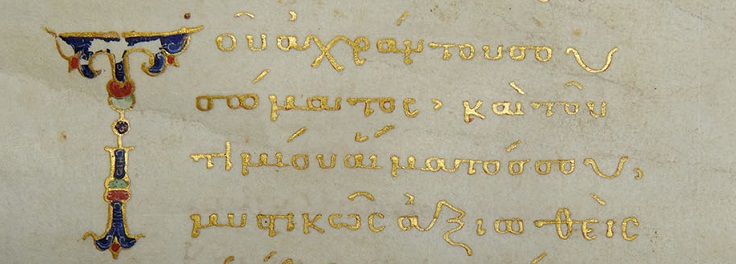
Keble College, Scroll 2, line 408
This image may be compared with Biblioteca Apostolica Vaticana, gr.1208, f. 278
The provenance of the scroll was until recently unknown. The leading clue about its provenance is on a cover leaflet, a paper of correspondence of approximately A5 in size that has ‘Shirle Hill, Sheffield’ embossed on its front. The impressive mansion ‘Shirle Hill’ was completed at Sheffield in the year 1809 and after 1852 it was owned by Sir John Brown until 1865 when it became the residency of William Bragge. William Bragge (1823–1884) was an engineer by profession and a major collector of illuminated manuscripts from medieval times and the renaissance. His collection was comprised of manuscripts of all languages, as he was interested in the illumination rather than their content. His collection was auctioned after his death by Sotheby & Co. on 7 June 1867. A further three of the Keble Greek manuscripts were bought in this auction (no. 50, 51, and 52).
The lot number of the scroll in that auction (no. 267) remains attached on the nineteenth-century stationery (essentially a leaflet) that is used to cover the scroll. The manuscript has been mislabelled in the auction catalogue as containing the text of the Greek liturgy of St John the Chrysostom. Yet, the identification of Keble scroll 2 with lot 267 in the Bragge sale can be little questioned, as not only the description fits the physical appearance of the medieval document, but also the catalogue reprints a note from the scroll’s cover letter, an excerpt from nineteenth century hit, Robert Curzon’s (14th Baron Zouche) Visit to the Monasteries in the Levant (London, 1849), pp. 404–405. The excerpt, which praises the rarity of Greek manuscripts written in gold letters thus endorsing the manuscript’s value, was copied while it was in Mr Bragge’s collection. A note identifying the text in the manuscript as an euchologion is carefully written under the passage from Curzon’s book and a later quick hand offers a more detailed description of the scroll’s contents on the outer side of the leaflet.
Parchment, 278 cm x 18.6 cm
Contents
The transcription of the text in full is available here.
lines 1–68. Prayer, inc.…κόνα, ἀλλὰ ποίημα καὶ πλάσμα σὸν γεγονώς, Akolouthia 18–22 [attributed to St Basil of Caesarea]
69–167. Prayer attributed to St John the Chrysostom. Εὐχὴ ἑτέρα τοῦ ἐν ἁγίοις πατρὸς ἡμῶν Ἰωάννου τοῦ Χρυσοστόμου. inc. Κ(ύρι)ε οἶδα ὅτι οὐκ εἰμὶ ἄξιος οὐδὲ ἱκανός, Akolouthia 22–25 (Taft, no. I.5)
167–234. Prayer attributed to St Symeon the Metraphrast. Εὐχ(ὴ) ἑτέρα τοῦ μεταφραστοῦ κυροῦ Συμεὼν. inc. Ὁ μόνος καθαρὸς καὶ ἀκήρατος κ(ύριο)ς, Akolouthia 25–27
234–262. Prayer. Εὐχὴ ἑτέρα. inc. Πιστεύω κ(ύρι)ε καὶ ὁμολογῶ ὅτι σὺ εἶ ὁ Χ(ριστό)ς, ὁ υἱὸς τοῦ Θεοῦ τοῦ ζῶντος, Akolouthia 52–53 [attributed to St John the Chrysostom]
264–340. Verses, Στίχοι [attributed to Symeon the Metaphrast]
264–270. inc. Νεουργὸν αἷμα φρίξον ἄν(θρωπ)ε, βλέπων, Taft no. I.7, Patrologia Graeca 114: 225C; Ὡρολόγιον τὸ Μέγα περιέχον τὴν πρέπουσαν αὐτῷ ἀκολουθίαν, Rome 1876, 319-20
271–278. inc. Ἰδοὺ βαδίζω πρὸς Θ(εο)ῦ κοινωνίαν, Taft no. I.3, Patrologia Graeca 114: 225B (2, vv. 4–7)
279-285. inc. Ταύτης δὲ τυχῶν τῆς καλῆς μετουσίας The text paraphrases Patrologia Graeca 114: 225C (4) to give instructions to the reader about the correct devotional practice.
285–321. inc. Ὁ δοὺς τροφήν μοι σάρκα σὴν ἑκουσίως. Patrologia Graeca 114: 224B–D
341–407. Prayer for after partaking in the Holy Communion. Ευχ(ὴ) μετὰ τὰ μεταλαβεῖν τὰ θεία μυστήρια. inc. Εὐχαριστῶ σοι Κ(ύρι)ε. Cf. Akolouthia, 56–57
407–418. Prayer. εὐχ(ὴ). Τοῦ ἀχράντου σου σώματος Cf. Endicott Scroll, Prayer 10, pp. 152-153, vv. 196–206
Decoration
68. Decorative band
72. Letter K
170. Letter Ὁ
235. Letter Π
254. Letter M
344. Letter E
408. Letter T
Bibliography
Diktyon no. 48654
Hutter I., Corpus der Byzantinischen Miniaturenhandschriften. Oxford Bodleian Library, Stuttgart, 1982, vol. 4, p. 29, no. 13
Wilson, N., in M. Parkes, The medieval manuscripts of Keble College Oxford: A descriptive catalogue with summary descriptions of the Greek and Oriental manuscripts (London, 1979), 333
Catalogue of a magnificent collection of manuscripts formed by a gentleman of consummate taste and judgment [William Bragge], Sotheby’s 7 Co. (London, 1876), p. 48, lot 267
On William Bragge as a collector see:
De Ricci, S., English collectors of books and manuscripts (1530–1930) and their marks of ownership (Bloomington, Ind., 1960), 155–156
See also:
Akolouthia = Ἀκολουθία τῆς θείας μεταλήψεωςι, ed. Β. P. Sekopoulos (Patras, 1871)
Endicott Scroll = Alexopoulos, S., and A. Van den Hoek, “The Endicott Scroll and Its Place in the History of Private Communion Prayers”, Dumbarton Oaks Papers 60 (2006), pp. 145-88, esp. 162–163 and 167–170
Taft = Taft, R., “Byzantine Communion Rites 2: Later Formulas in the Ritual of Clergy Communion”, Orientalia Christiana Periodica 67: 275–352
* I am grateful to my tutor of codicology Dr Georgy Parpulov for his help and our discussions.
MANUSCRIPT 4: A Gospel lectionary book
A Gospel lectionary is an essential liturgical book for every Orthodox Church. It contains the readings from the Gospels to be read on a particular day. The readings are arranged in two cycles: the moveable feasts (depending on the date of Easter) and the fixed ones.
The Keble Greek lectionary misses three gatherings and a leaf at the beginning and an unclear number of pages at the end. The readings for the movable feasts begin after the fifth week of the Byzantine year (starting on September 1st). As expected for a liturgical gospel book, the main text is written in perlschrift (a script named thus because it contains ornamental ‘pearls’, small plombs) and the titles in a majuscule script that is reminiscent of monumental inscriptions. The ekphonetic signs – the red signs noted above the text at the end of the readings – would have guided the reader’s voice while performing the text.

Keble MS 4, f. 57
Irmhand Hutter has already noticed the striking similarity between Keble Library’s manuscript no. 4 and manuscript no. 133 of the National Library of Greece in Athens. The Athenian manuscript, a gospel lectionary with the apostolic epistles, has been tentatively associated with a renowned monastic foundation of the twelfth century, the monastery of Hosios Meletios in Attica, Greece. That connection is made on account of the exceptional celebration of the memory of St Meletios the Younger on the first of September, something which is not replicated in the Keble manuscript. Hutter tried to endorse that connection suggesting that the decorative motifs resemble those in the eleventh-century lectionary of the manuscript (National Library of Greece, no. 69). However, one should note some resemblance of the decoration to contemporary manuscripts from Epirus and thus suggest a localisation of the manuscript’s production in the Greek mainland, and a probable but far from certain connection to the monastery of Hosios Meletios.
Caspar René Gregory (1846–1917), a pioneer in the edition of the text of the Greek New Testament, studied Keble’s manuscript no. 4 in the year 1883 and he added a note about missing leaves and texts on the reverse side of the book cover. In his fundamental publication Das griechischen Handschriften des Neuen Testament (Leipzig, 1908, p. 133), the Keble manuscript is recorded as lectionary 343, compared to minuscule 298.
The manuscript was studied by Gregory a year after it was donated to Keble College (1882) by the Reverend Greville J. Chester, a pioneer in archaeology and a passionate collector of especially Egyptian antiquities. Chester donated manuscripts also to Balliol College and the Bodleian.
The microfilm of the manuscript has been digitised by the Institut für Neutestamentliche Textforschung, ID 40343
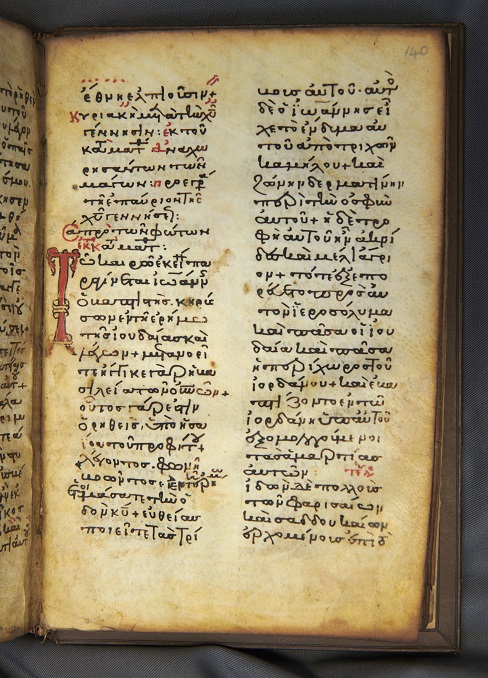
Keble MS 4, f. 140
Parchment. 245 x 160 mm, i-ii + 151 leaves + iii-iv
Gatherings: 1×7 (7), 4 x8 (39), 1×7(46), 1×8 (54), 1×7(61), 6×8(109), 1×5(115), 1×8 (123), 1×7 (130), 1×8 (138), 1×7 (145), 1×1 (146), 1×5 (151)
Gatherings numbers: 7v (δ), 16 (στ) 23v (στ), 31v (ζ), 39v (η), 46v (θ), 54v (ι), 61 (ια), 69v (ιβ), 77v (ιγ), 101v (ιστ), 123v (ιθ), 138v (κα)
Missing folia: three quires before and a folio before f. 1, two folia after f. 110, one folio after f. 115, one folio after f. 146, at least three folia after 151.
Binding: nineteenth century
Contents
ff. 1–19. Readings for the weeks of John
ff. 19–39v. Readings for the weeks of Matthew
ff. 40-66. Readings for the weeks of Luke
ff. 66–67. Reading for the Vigil
ff. 67v-78. Readings for Lent
ff. 78–120v. Readings for the Holy Week
ff. 121–153. Menologion. Readings for the immovable feast days from 1 September through 21 May.
Notable decoration
Pyle: 19, 67v, 121
Headpiece: 98, 130v, 132v, 141
A small fish is drawn at the margins of f. 119v
A number of initials are also decorated.
Bibliography
Diktyon no. 48650
N. Wilson in M. Parkes, The medieval manuscripts of Keble College Oxford: A descriptive catalogue with summary descriptions of the Greek and Oriental manuscripts (London, 1979),
Irmhand Hutter (Corpus der Byzantinischen Miniaturenhandschriften. Oxford Bodleian Library, Stuttgart, 1982, vol. 4, 30–31.
On manuscript 133 of the National Library of Greece see : A. Marava-Chatzinicolaou and C. Toufexi-Paschou, Κατάλογος μικρογραφιών βυζαντινών χειρογράφων της Εθνικής Βιβλιοθήκης της Ελλάδος, vol. I. Χειρόγραφα Καινής Διαθήκης Ι΄–ΙΒ΄ αιώνος (Athens, 1978), 32–37.
MANUSCRIPT 50: Sticherarion according to Germanos of Neai Patrai
Sticherarion is a type of chant book widely used in the Orthodox church. The sticherarion contains the musical setting of the stichera of daily services and feasts. The manuscript contains the sticherarion as revised by Germanos, the bishop of Neai Patrai (Hypati, Phthiotida, Greece) in the seventeenth century. The manuscript however dates from nearly a century later, the middle of the eighteenth century. Similar manuscripts to Keble manuscript 50 were often copied in monasteries on the Holy Mountain (Hagion Oros) and indeed the script of the main scribe of the Keble medieval book has been compared to that of manuscripts in the Panteleemon monastery (and other monasteries).
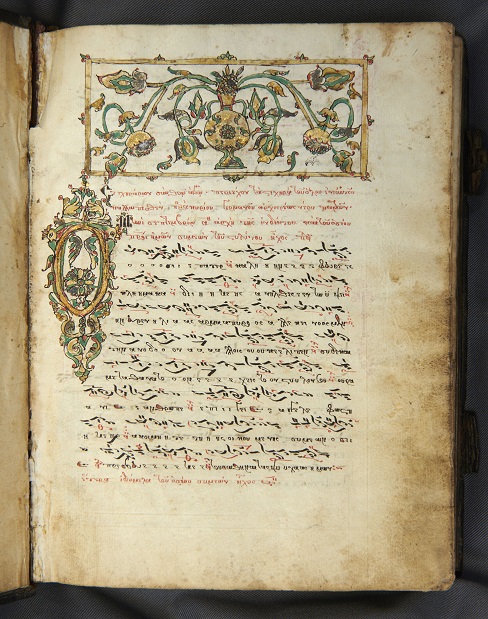
Keble MS 50, f.1, showing ornamental flower pot headpiece
This sleek, illustrated, paper manuscript has a height of just 20.7 cm and width 15.1 cm. It is a diligently decorated book with an ornamental flower pot spread across the headpiece on the first page. Illustrated bands can be seen in ff. 34, 59v, 95v and 147. Elegantly decorated initials can be found throughout the volume. The text is written in a single column with approximately 16 lines per page. It maintains its original bookbinding and initially it was part of a set of two volumes. This first volume covers the period between September (the beginning of the ecclesiastical year) and January. At the end of the book there is a note that this is the end of the first volume.
The exact provenance of the book is not known, as early possessors’ notes are now erased. The manuscript was among those collected by the late brother of Canon Charles E. Brooke, Sir Thomas Brooke. Canon Brooke bequeathed the precious collection of mainly Western manuscripts to the college in 1911. The manuscript was originally bought on 7 June 1876 (Lot no. 282) at a famous auction following the death of the passionate collector and antiquarian William Bragge organised by Sotheby’s.
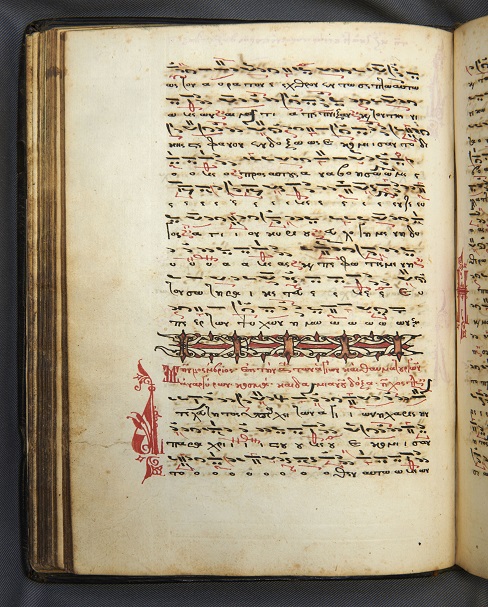
Keble MS 50, f. 59v, showing illustrative band
Paper, 20.7×15.1, i–ii + 200 ff. + iii
Gatherings: 1×2 (2), 2×8 (18), 1×6 (24), 7×8 (79), 1×7 (85/86), 9×8 (157/158), 1x9 (166/167), 1×7(173/174), 3×8(197/198), 1×2(199/200) (Folio 81 was left without a number initially. A second modern hand renumbered all folia starting from f. 81.)
Gatherings numbering: 10v (α), 18v (β), 24v (γ), 32v (δ), 40v (ε), 48v (στ), 55v (ζ), 63v (η), 71v (θ), 79v (ι), 85v/86v (ια), 93v/94v (ιβ), 101v/102v (ιγ), 109v/110v (ιδ), 117v/118v (ιε), 125v/126v (ιστ), 133v/134v (ιζ), 141v/142v (ιη), 149v/150v (ιθ), 166v/167v (κα), 173v/174v (κβ), 181v/182v (κγ), 189v/190v (κδ), 197v/198v (κε)
Contents
f. 1. blank
f. 1v. Outline of the music Klimax according to Manuel Chrysaphes
ff. 1v–199v/200v. Sticherarion according to Germanos of Neai Patrai (single hand, first half of the eighteenth century)
f. 199v/200v. Recipes for making pills and syrups (nineteenth century)
Notable decorations
Impressive headband: f. 1
Highly decorated initials until f. 32v
Bibliography
Diktyon no. 48651
Giannopoulos, E., 2008, Τὰ χειρόγραφα βυζαντινῆς μουσικῆς, Ἀγγλία, Athens 2008, 284–285 (detailed description)
Wilson, N., in M. Parkes, The medieval manuscripts of Keble College Oxford: A descriptive catalogue with summary descriptions of the Greek and Oriental manuscripts (London, 1979), 243
Catalogue of a magnificent collection of manuscripts formed by a gentleman of consummate taste and judgment [William Bragge], Sotheby’s 7 Co. (London, 1876), p. 51, lot 282.
MANUSCRIPT 51: Sticherarion of the entire year
The modest manuscript Keble no. 51 is another music manuscript. Its 165 folia contain a sticherarion, but not the version included in manuscript 50. Manuscript 51 dates from the middle of the sixteenth century and its script has been compared to that of music manuscripts from Crete (such as manuscript Additional 57942 of the British Library). One main scribe copied ff. 1–127, which contains the stichera of daily services and of several major feasts. Then a few notes follow (128–136v) but after f. 137 a later scribe has copied the full service for Saint Theodore the Tyron and Saint Theodore the Stratelat (June, 8) and subsequently the exapostilarion to the feast day of the two Theodores, Stratelates and Teron. The manuscript contains adorned initials and a number of decorative bands. The manuscript misses its final pages. Its impressive original book binding with embossed leather and projecting metal pieces remains attached to the book.
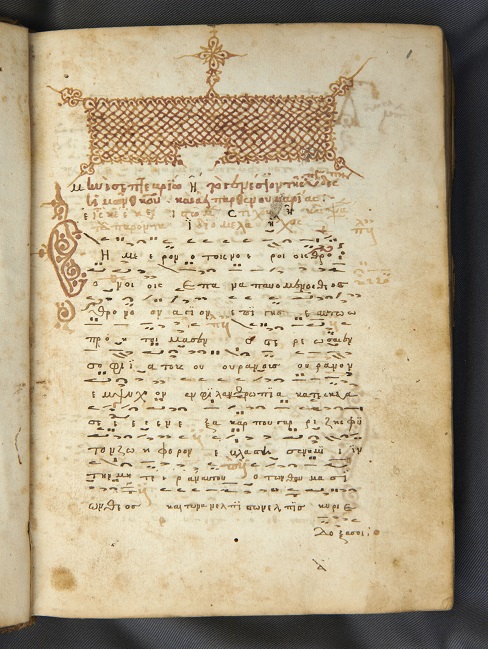
Beginning of the sticherarion, Keble MS 51, f. 1
The manuscript was bequeathed to the college by Canon Brooke together with manuscripts 50 and 52. The manuscript was lot no. 281 of the Bragge sale (7/6/1876, Sotheby’s), when it was originally bought by Canon Brooke’s brother Sir Thomas Brooke.
Paper, 20.7×14.8 cm, i-iv +165 ff.
Quires: 2×6 (12), 8×8 (76), 2×7(90), 3×8(114), 1×10 (126), 4×8 (159), 1×6 (165)
Decorative bands: ff. 24, 27, 35, 43r–v, 47v, 54v, 58, 64, 69v, 74v, 80

Liturgical service (akolouthia) for Saint Theodore Stratelates (June 8), Keble MS 51, f. 137
Bibliography
Diktyon no. 48652
Giannopoulos, E., 2008, Τὰ χειρόγραφα βυζαντινῆς μουσικῆς, Ἀγγλία, Athens 2008, 285–288 (detailed description)
Wilson, N., in M. Parkes, The medieval manuscripts of Keble College Oxford: A descriptive catalogue with summary descriptions of the Greek and Oriental manuscripts (London, 1979), 243
Catalogue of a magnificent collection of manuscripts formed by a gentleman of consummate taste and judgment [William Bragge], Sotheby’s 7 Co. (London, 1876), p. 51, lot 281
MANUSCRIPT 52: LITURGY
Books with the liturgy in Greek were first printed in 1526, but the number of copies was limited and for Greek books in general printing was not popular until the seventeenth century. Thus, it is of little surprise that manuscript 52 of Keble college is a handwritten book, a carefully crafted manuscript with rich illustration, including authors’ portraits and capital letters, dating as late as the seventeenth century.
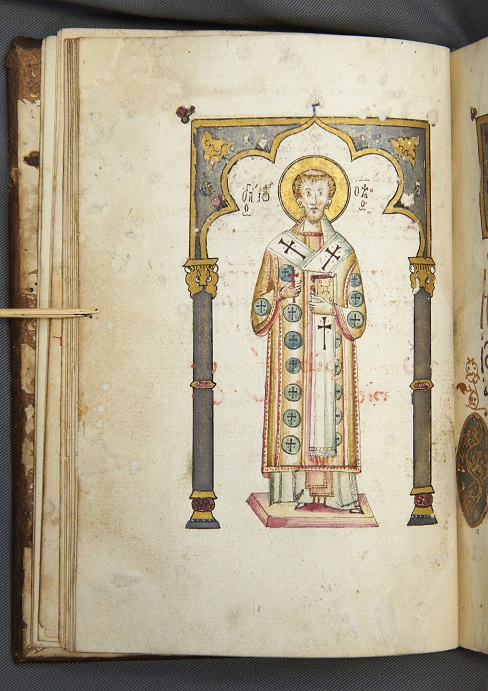
Portrait of Saint John the Chrysostom, Keble MS 52, f. 9v
This book contains the two main versions of the liturgy still in use in the Greek Orthodox church, that of John the Chrysostom and Basil of Caesarea. Then the liturgy of the so-called pre-sanctified gifts attributed to Gregory ‘Dialogus’ (Gregory the Great) follows. The three texts are preceded by an introduction to the liturgy by the fourteenth-century author and patriarch of Constantinople, Philotheus Kokkinos, a text that became rubric after its first printed edition.
A note in folio 115v reveals that the book was copied in 1618 by the monk Ioannikios of the Barlaam monastery at Meteora. The intrinsic full or half page miniatures and lavish decorative motifs showcase the elegance of the art developed during the seventeenth century in central Greece, which was part at the time of the Ottoman empire. Τhe painter and scribe of the manuscript, the monk Ioannikios, is a well-recognised artist of early modern Mediterranean art. Ioannikios follows a style that was trialled in Meteora. That style combined equally in the decorative motifs influences from the Italian west and the Ottoman east and gave preference to a linear style in the shape of the figures, while opposing ‘official’ mandates supported in the region that were influenced by Cretan painting. The motifs for example next to the miniature of St John the Chrysostom find parallels in frescoes at the main church (the katholikon) of St Stephen monastery, also in Meteora.
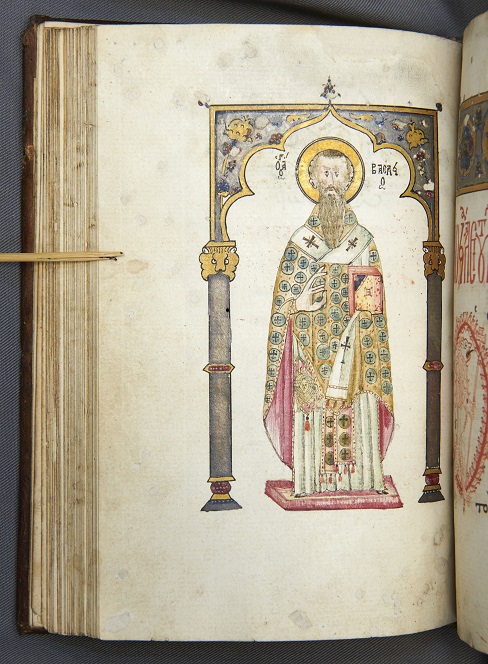
Portrait of Saint Basil (the Great), Keble MS 52, f. 44v
The manuscript became part of the college’s collection after the bequest of Canon Brooke from the collection of his brother Sir Thomas Brooke, who bought the manuscript in 1876 together with MSS 50 and 51.
Paper, 80 x 12.8 cm, ff. i–iv + 116
Quires: 1×8(8), 1×1(9), 3×8(33), 1×7(40), 3×8(63), 1×10(74), 5×8(114), 1×2(116)
Missing pages: a folio between 35 and 36
Binding: original, leather with golden stamp
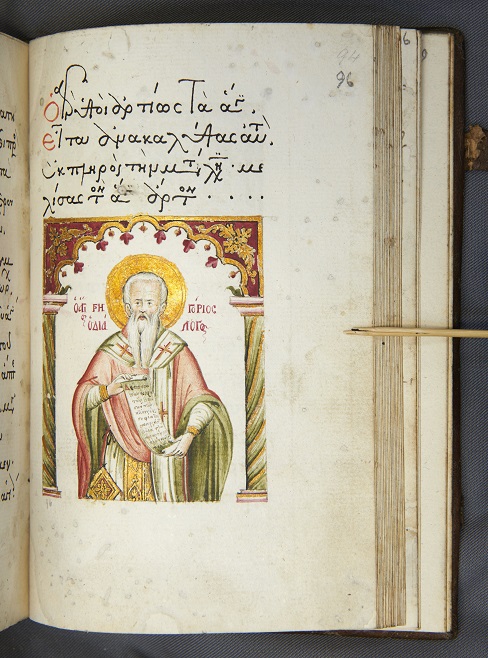
Portrait of Saint Gregory “the dialogue” (Saint Gregory the Great), Keble MS 52, f. 96
Content/Notable Decoration
ff. 1–8v. Philotheos Kokkinos, Introduction to the Divine Liturgy, ed. Patrologia Graeca 154:745–766
f. 9. Blank
f. 9v. Miniature of St John the Chrysostom
ff. 10–44. The Divine Liturgy according St John the Chrysostom
f. 44v. Miniature of St Basil of Caesarea
ff. 45–93. Divine Liturgy of St Basil of Caesarea
ff. 93v–96. Divine Liturgy of the Pre-sanctified gifts
f. 96. Miniature of St Gregory ‘Dialogus’
f. 116. Inventory of an unidentified church dated to the year 1715
f. 116v. Blank
Bibliography
Diktyon no. 48653
Hutter, I., Corpus der Byzantinischen Miniaturenhandschriften. Oxford Bodleian Library (Stuttgart, 1982), vol. 4, pp. 31–34
Wilson, N., in M. Parkes, The medieval manuscripts of Keble College Oxford: A descriptive catalogue with summary descriptions of the Greek and Oriental manuscripts (London, 1979), 244
Catalogue of a magnificent collection of manuscripts formed by a gentleman of consummate taste and judgment [William Bragge], Sotheby’s 7 Co. (London, 1876), p. 51, lot 283
* I am grateful to Dr Theocharis Tsampouras for his comments on the monk Ioannikios.
